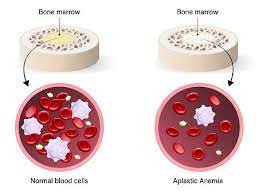Definition
White blood cells in the body play an important role in the immune system by fighting infections caused by viruses, bacteria, fungi, and other foreign substances. One type of white blood cell, granulocytes, has a crucial role in the immune system because it contains specific enzymes that can kill bacteria and other foreign objects. Without white blood cells, the body could not effectively combat and eliminate dangerous bacteria or viruses.
Agranulocytosis is a serious condition characterized by the body's inability to produce a sufficient amount of granulocytes. This deficiency can be life-threatening due to low levels of white blood cells, specifically neutrophils. The term 'agranulocytosis' derives from 'granulocyte,' which comprises three main types: neutrophils, eosinophils, and basophils. Neutrophils are the most abundant type of granulocyte.
Agranulocytosis, also called granulocytopenia, is a more severe form of neutropenia in which the neutrophil count falls below the normal range for white blood cells. Neutropenia is diagnosed when the neutrophil count is less than 1500 neutrophils per microliter (µL) of blood. However, when the count drops below 100 neutrophils per microliter of blood, it is classified as severe neutropenia or agranulocytosis.
Agranulocytosis can be categorized into two main types:
- Inherited Agranulocytosis
This type is attributed to genetic disorders that impede the body's capacity to generate neutrophils, often affecting the bone marrow. It is frequently observed in infants and children.
- Acquired Agranulocytosis
This form can stem from diverse factors and commonly manifests as a medication side effect. It is more prevalent among adults.
Causes
Agranulocytosis occurs when the body's neutrophil count drops too low. This can result from insufficient neutrophil production or premature destruction of existing neutrophils.
In inherited agranulocytosis, genetic factors impair the body's ability to produce an adequate number of neutrophils. Conversely, acquired agranulocytosis can be triggered by various factors, including certain medications, infections, exposure to chemicals, and underlying health conditions.
Examples of conditions that can lead to acquired agranulocytosis include autoimmune diseases like lupus and rheumatoid arthritis, bone marrow disorders, cancers affecting the bone marrow, cancer treatments, exposure to toxic chemicals such as lead or mercury, infections such as malaria and tuberculosis, inadequate nutrition or vitamin deficiencies, and the use of certain medications like specific antibiotics, antipsychotics, and drugs for thyroid disorders.
Risk factor
While agranulocytosis can affect individuals of all ages, it is more commonly observed in females. Certain factors increase the risk of developing this condition, including:
- Undergoing chemotherapy as part of cancer treatment.
- Having autoimmune disorders, such as lupus or rheumatoid arthritis, where the body's immune system attacks its own tissues.
- Taking specific medications, including clozapine, trimethoprim/sulfamethoxazole antibiotics, and methimazole for thyroid disorders.
Symptoms
Agranulocytosis can manifest with sudden or gradual onset of symptoms, including:
- Fever and chills
- Increased heart rate and breathing
- Muscle weakness and fatigue
- Bleeding and swelling in the gums
- Pain in the mouth and throat area, leading to difficulty breathing
- Sudden drop in blood pressure (hypotension), resulting in dizziness or fainting
Diagnosis
The diagnosis of agranulocytosis typically involves several steps, including medical history assessment, physical examination, and diagnostic tests.
Your doctor will begin by gathering information about your symptoms, recent medications, infections, and potential chemical exposures through a medical interview. Following this, a comprehensive physical examination will be conducted, including checking your blood pressure, respiratory rate, pulse rate, and body temperature.
One key diagnostic test for agranulocytosis is a complete blood count (CBC), which measures the levels of various blood components, including neutrophils. Agranulocytosis is diagnosed when the absolute neutrophil count (ANC) falls below 100 neutrophils per microliter of blood, compared to the normal range of at least 1500 neutrophils per microliter in adults.
In some cases, your doctor may recommend obtaining a bone marrow sample through biopsy and aspiration to evaluate the bone marrow's ability to produce neutrophils. The bone marrow, located within the bones, generates various blood cells, including neutrophils.
Management
If medication is identified as the cause of agranulocytosis, it's crucial to discontinue it immediately and inform your doctor about the treatment. Your doctor may recommend replacing the medication with a safer alternative.
Treatment options for agranulocytosis may include:
- Antibiotics: If you have an infection, your doctor will likely prescribe antibiotics to alleviate symptoms and combat the infection.
- Granulocyte Colony-Stimulating Factor (G-CSF): Injectable medications such as filgrastim, pegfilgrastim, or lenograstim may be recommended to stimulate the production of neutrophils in your body, helping to restore levels more rapidly.
- Immunosuppressants: In cases where an autoimmune disorder is the underlying cause of agranulocytosis, medications that suppress the immune system, such as prednisone, may be prescribed to mitigate the immune response.
- Bone Marrow Transplantation: A bone marrow transplant may be necessary if other treatment modalities prove ineffective. During this procedure, donor bone marrow is transplanted into your body to facilitate the production of healthy neutrophils.
Complications
Agranulocytosis significantly elevates the risk of chronic or recurrent infections. If it persists for more than 3 to 4 weeks, the likelihood of infections approaching nearly 100%. Without prompt and appropriate treatment, agranulocytosis can escalate into life-threatening conditions, primarily due to an overwhelming immune system response known as sepsis.
Certain populations, including elderly patients aged 65 years and older, as well as individuals with pre-existing health disorders such as liver, kidney, and lung issues, are particularly vulnerable to experiencing complications associated with agranulocytosis.
Prevention
While agranulocytosis cannot be prevented, there are steps you can take to manage its risk factors and minimize the likelihood of infections:
- Inform your doctor if you are taking medications known to lower neutrophil levels. Your doctor may adjust your treatment plan and recommend regular blood tests to monitor your neutrophil count.
- If you are undergoing chemotherapy for cancer, your doctor may suggest Granulocyte Colony-Stimulating Factor (G-CSF) injections to boost your body's production of neutrophils.
- Attend regular check-ups with your doctor to monitor your neutrophil levels and identify any potential complications early on.
- Practice good hygiene habits, such as frequent handwashing, to reduce the risk of infections. Consider wearing masks in public places to protect yourself further, especially if your neutrophil levels are low.
When to see a doctor?
Agranulocytosis is a life-threatening condition, underscoring the critical need for prompt diagnosis and treatment. If you experience symptoms of infection, it's imperative to inform your doctor promptly. Be sure to communicate the frequency and duration of your infections accurately.
Despite its severity, agranulocytosis is treatable. Therefore, it's essential to contact your doctor immediately if you experience symptoms of infection, particularly if they are recurring or persistent.
Looking for more information about other diseases? Click here!
- dr. Monica Salim
Agranulocytosis. (2017). Retrieved 04 April 2023, from https://www.medicalnewstoday.com/articles/318790
What is Agranulocytosis. (2021). Retrieved 04 April 2023, from https://www.verywellhealth.com/agranulocytosis-5198079
Agranulocytosis. (2023). Retrieved 04 April 2023, from https://my.clevelandclinic.org/health/diseases/15262-agranulocytosis
Agranulocytosis. (2022). Retrieved 04 April 2023, from https://medlineplus.gov/ency/article/001295.htm
Agranulocytosis. (2017). Retrieved 04 April 2023, fromhttps://www.healthline.com/health/agranulocytosis











